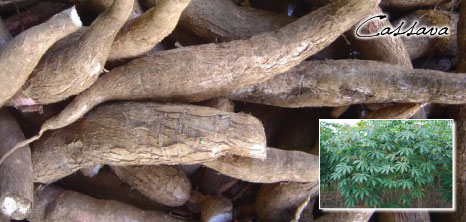|
CassavaThe cassava root is long and tapered, with a firm rough, brown flesh that encloses its yellowish flesh. The plant originated in Central America/Northern South America and has been a long-standing crop on the island of Barbados. In recent times, emphasis has been put on this particular crop in an effort to see it produce secondary and tertiary products such as cassava breads, muffins, cakes and its usage as a substitute for corn in animal feed.
Also known as yucca, cassava is the third largest source of carbohydrates in the world and is a principal food for millions of people worldwide. Among crop plants, next to sugarcane, cassava provides the highest yield of food energy per cultivated area per day.
HarvestingThere is no real mature stage for cassava as the actual plant is ready for harvest as soon as there are storage roots large enough to meet the requirements of the consumer.
Cassava on the island of Barbados is harvested by hand but ropes can be used for tougher crops. The method includes lifting the lower part of the stem and pulling the roots from the ground, then removing them from the base of the plant. Before harvesting, the upper parts of the stems are removed. The roots of the cassava plant are quite vulnerable and if tampered with too much, can easily prohibit the shelf life of the harvested plant. The cuttings for the next crop are selected during this harvesting period. These cuttings must be kept in a safe and secure environment in order to prevent desiccation.
PreparationAll forms of the cassava plant contain a cyanogenic glycoside. Toxic cyanide levels are found in 'poison cassava' and certain precautions must be taken in preparing this. Tubers must to be cooked thoroughly and they must be washed, boiled and the water used to prepare them thrown away. For most purposes, the tubers are peeled and grated uncooked and the liquid removed by wringing the grated tuber in a cloth. The grated cassava is dried in the sun for several days and can then be used to prepare pone or cassava bread. A starch can also be prepared from the liquid wrung out of the grated cassava.
Preparation of cassavas in Barbados, take on a process of being peeled and boiled, baked, or fried. Cassava is not the kind of food that should be consumed uncooked based on its potentially toxic concentrations of cyanogenic glucosides. Through the process of cooking, these high levels of cyanogenic glucosides are reduced to harmless levels.
Roots are grated and the sap expressed through a process of squeezing. Drying of the cassava is then accomplished over a fire that prepares it in a way suitable for a meal. A popular way of preparing cassava in Barbados is to cook it and serve it with melted butter.
Health Benefits of Cassava to BarbadosCassava roots are very rich in starch and contain significant amounts of calcium, dietary fiber, iron, manganese, phosphorus, potassium, vitamin b6 and vitamin C. In contrast, cassava leaves are a good source of protein and rich in the amino acid lysine
The control and prevention of cardiovascular diseases, colon cancer and diabetes has been attributed to the dietary fiber in cassava. Other studies indicate the importance in cassava possibly supporting the nervous system and helping to alleviate stress, anxiety and irritable bowel syndrome. |



